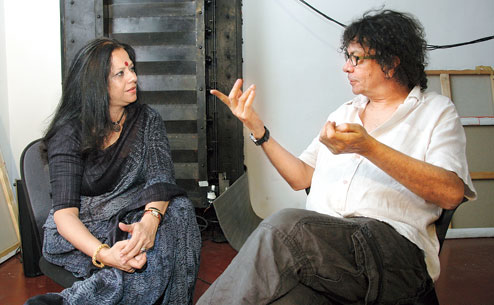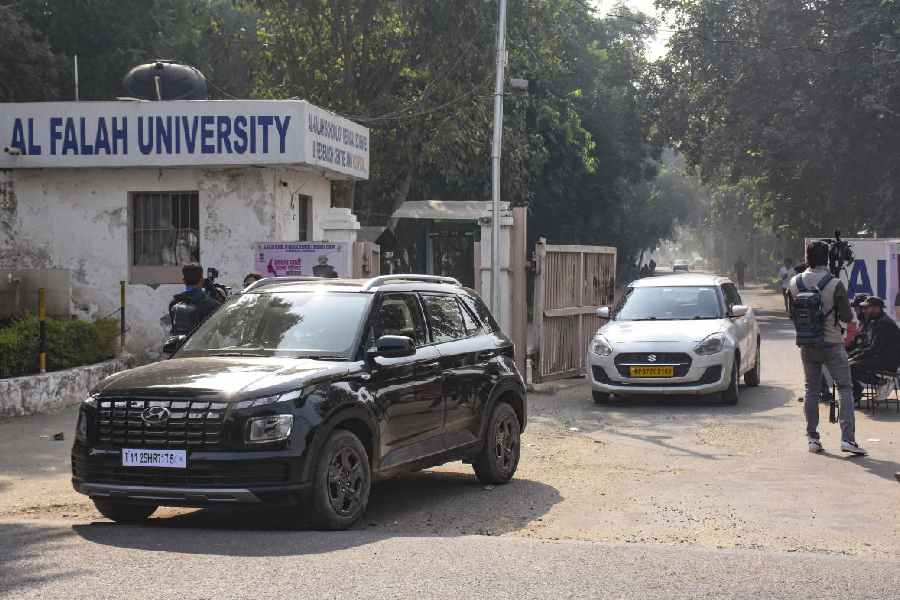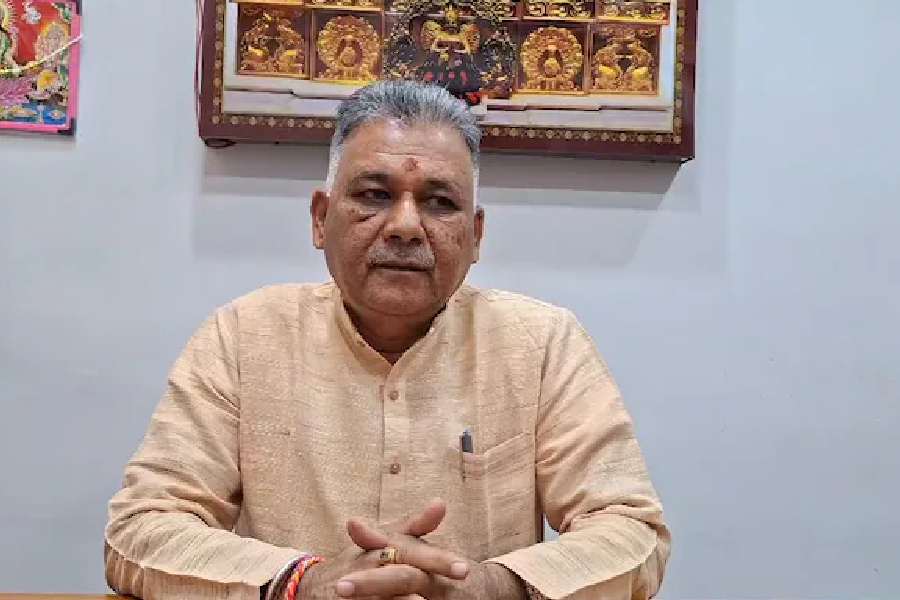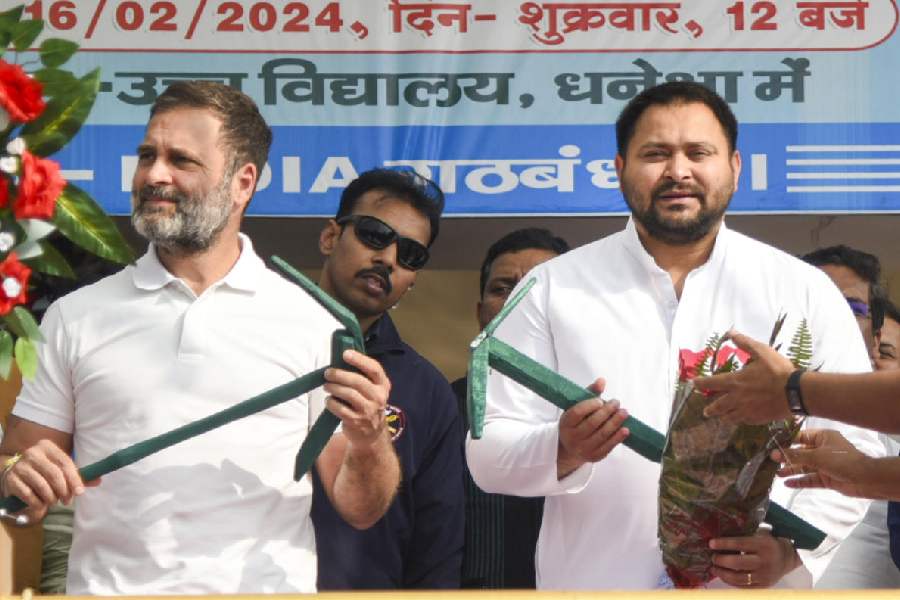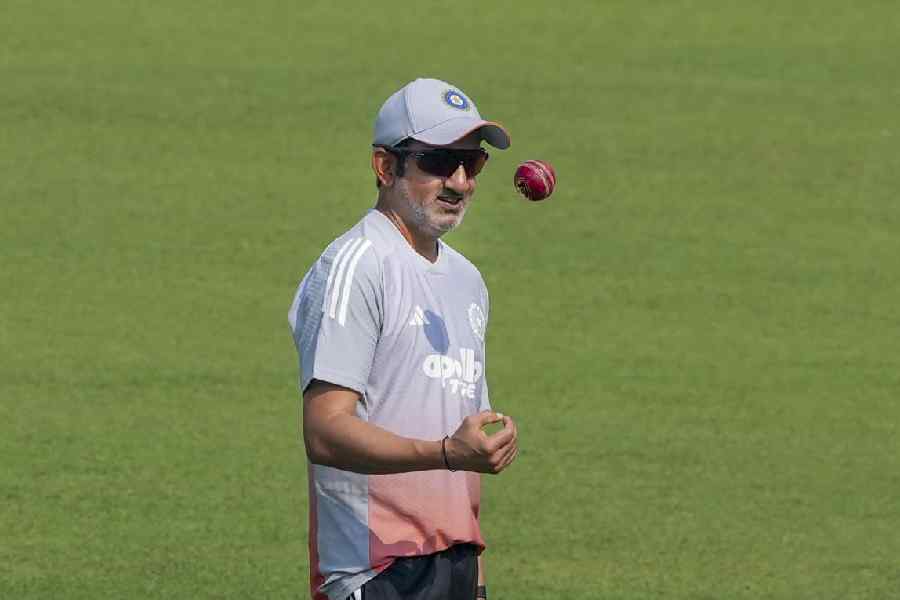They’d both gone to Patha Bhavan School, both been misfits of a kind and both come from atypical families. Chittrovanu, son of artist Nirode Mazumdar and Marguerite Mazumdar, had a half-French, half-Bengali upbringing that set him apart. And Ina, coming from Bombay to live in Calcutta, did not really fit in with ease. Years later, part of the same world now — one creating, one commenting — they find it easy to look back and trace how it all began.
 |
| Chittrovanu Mazumdar in conversation with curator Ina Puri at his Harrington Street studio. Picture by Sanat Kumar Sinha |
Ina: When was it… 1967, 1968? In Patha Bhavan?
Chittrovanu: Yes, it was around that time. For me it was such an extraordinary experience. I had been sent to a village school before; my father had the idea that it would be good for me, chhite berar dormar school, and from there to Patha Bhavan was a shock.
Ina: We’d just come to Calcutta from Bombay. I couldn’t even speak Bengali. Umadi (Uma Sehanobis, the first principal of Patha Bhavan) was boromashi’s (Mahasweta Devi) friend. She felt that if I was sent to Patha Bhavan I’d get a well-rounded education.
Chittrovanu: That’s true. It was a very different kind of school. We had the liberty to think. We had the exposure to different ideas and arts, exhibitions and cinema.... School was a space where we learnt to think differently. But things are different at that age. It’s difficult to decide what you’d do. I was more interested in playing cricket and smoking cigarettes at that stage.... Umadi certainly has to get the credit for me passing school. I still have nightmares about examinations. Writing and writing and writing.
I had a sense of not belonging, not fitting in. And in some ways it held dark places, which is not always a bad thing because it helps you find yourself and then look back.
The sense of displacement, of not belonging, persists even now…
Ina: But I do remember your house as being a very happy place. I used to be picked up by the school bus first and there you’d be, in a bustling house with a number of cats and lots of people.... How was it, growing up with your father?
Chittrovanu: It was not ordinary. Had some completely dark moments. It is very difficult to have two creative people in the same house. And they were a terrible generation. There were dark places. But it’s amazing how they created the art they did. We have a market, we have resources, but they just created for the sake of art itself. There were not too many art buyers then.
Ina: Who were your father’s contemporaries?
Chittrovanu: Paritosh Sen, Pradosh Dasgupta and others...
Ina: What happened to your father’s paintings?
Chittrovanu: They’re with us. None of them were sold. My mother wouldn’t even think of it.
Ina: It must be difficult to preserve them?
Chittrovanu: We try. And he was not a careful painter. He’d do just what he wanted to do. It was difficult to keep those paintings in good shape. But the ones that my sister has in France are in much better condition.
Ina: He must have been one of your influences...
Chittrovanu: My father was, naturally, but there are too many to name. And it’s not like influences are restricted to art. You read you listen, you see, you hear, you revisit conversations, like you were talking about backgrounds in Manjit’s (Bawa) paintings and it struck me I’ve never really thought about it. You keep engaging, you think and you learn continuously — otherwise we’d still be sitting in caves painting on the walls.
Ina: You must hold an exhibition of them.
Chittrovanu: We might.
Ina: Talking of exhibitions, I’m a bit worried. After your last exhibition [‘...and undated Nightskin’ at the Harrington Street Arts Centre and extending to his studio in the same building], such a brilliant show, what will you do next, how will you move beyond?
Chittrovanu: Oh, I have moved beyond. If you live in that, it could be your burial. You have to destroy memories; I start dismantling them as soon as it’s over. It has to die for something new to be born.... And that phase is one of anxiety for writers, for artists. These are moments one has crossed.
It’s true for any medium. And it’s dark and painful. How do you transcend that moment and create something afresh? Think of Ulysses. Think of Godard’s movies. After the first, second, third one, how could he come at the fourth?
It is an intensely private thing and it is very traumatic to give it up to the public. When you start, there’s no audience. It is extremely selfish. After a while, it becomes more inclusive. It’s the same for writers and film-makers. There’s no point of reference. The man who walks in to see your movie or read your book, has no clue what you went through...
Look at you Ina, when you give your talks or write about Manjit, you have to make that decision — how much of what is personal can be shared, and yet, to create something enduring, you have to give it up.
Ina: Yes, it is difficult because it’s very personal... I learnt about Manjit’s work from Manjit himself. He’d always talk while he worked... It’s as if he gave me X-ray vision — mixing colours, techniques, backgrounds... he prepared me on the things I should know about him. When I talk about Manjit, when I’m sharing, it happens on its own, but afterwards I am so drained.
Chittrovanu: But then, you need that darkness. This [the process of creating] is not a joyous thing. For me, my sense of displacement persists...
I mean, home is otherwise just a physical location.... If it’s craft, years of practice may give you a sense of being at home. But this is more painful, born out of something more dark.
If it were not so, I’d be painting charte maharaja, charte ghora, everybody would be happy, the market would be appeased and I’d keep doing that. But you can’t do that. You have to keep on doing something new.
Recognition factor stalls art. The day you change, your market dies with you because the joy of recognition (for the buyers) is gone and artists toe that line. Ei to shei gaan, ei to shei chhobi, this ability to identify gives people a certain pleasure. But one should learn to enjoy the challenge of non-recognition... I do not recognise the style or the artist, let me explore this more.
Ina: A lot of international artists have their signature style and can be recognised though...
Chittrovanu: Yes, but art is the only place where you display that rupture, you have to break the mould and carry on a subversion... You create your own language, you hesitate, you do what is not done... (Jimi) Hendrix became Hendrix by doing that. He hit the dirty notes... I cannot see an artist having a comfort zone; you have to become a terrorist.
We need to create that space where young artists think beyond craft, beyond perfecting technique. Art nowadays is about executing something with finesse. There is a thinking behind it too, which gets ignored.
Artists have to have a certain exposure. When you study in the same college and then graduate and come back to teach there, there is nothing new for you to explore. We have to see that newness.
Ina: Things like residencies.
Chittrovanu: Yes, somebody telling them ‘go and see this, go and live there, go see this work’. Young people need that exposure. Something like the Art Summit. It’s huge and it offers such a lot. And such initiatives are not being reflected in the process of making art.... It’s not only about the site.
The public and the youngsters need to see new things too. Our young artists need to have that vision, that energy, that exposure to good international art.
After all, Bengal used to have that energy. There has to be an art museum in Calcutta. All the big exhibitions come to Delhi or to Mumbai and leave.
Ina: Yes, it’s a pity. I keep thinking they must come to Calcutta; there’d be hundreds of people. But then, we launched Take on Art magazine here, and how many copies sold? One.
Chittrovanu: People don’t come out to see art much any more. Life’s taken over by television. They don’t buy books. We used to have a tradition of giving books as birthday presents. But it is a worldwide malaise. Bookshops are closing down.
It’s difficult to get people to come and open up to something new. I was pleasantly surprised to see I had so many people coming in for my exhibition [‘...and undated Nightskin’]. Even after days, people would come in from villages, they’d heard about it and come to see.

